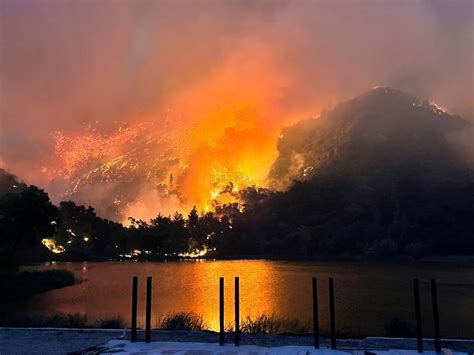The Zaca Lake Fire, a catastrophic wildfire that scorched a significant portion of the Los Padres National Forest in California, is a stark reminder of the devastating power of uncontrolled blazes. This fire, which began in July 2007, would go on to become one of the largest wildfires in California’s history, rivaling the scale and destructive potential of other notable wildfires such as the Cedar Fire and the Witch Creek Fire.
Background and Causes
The Zaca Lake Fire ignited on July 4, 2007, in a remote area near Zaca Lake, within the Los Padres National Forest. The exact cause of the fire was determined to be human-related, although the specifics of how it started were not fully disclosed. What is known, however, is that the combination of arson and the extremely dry conditions prevailing in the region at the time created the perfect storm for a wildfire of unprecedented proportions.
Spread and Impact
Over the ensuing weeks, the Zaca Lake Fire spread rapidly, fueled by strong winds, high temperatures, and the prevailing dry conditions. By the time it was finally contained on September 4, 2007, the fire had burned an area of over 240,000 acres, making it one of the largest wildfires in California’s history up to that point. The fire’s impact was not limited to the environmental damage it caused; it also had significant economic and social implications. Numerous homes and outbuildings were destroyed, and thousands of people were forced to evacuate their homes as the fire approached.
Firefighting Efforts
The response to the Zaca Lake Fire was immediate and extensive, involving thousands of firefighters from local, state, and federal agencies. The firefighting effort was challenging due to the fire’s remote location and the difficult terrain, which made accessing the firelines problematic. Despite these challenges, firefighters worked tirelessly, employing a range of strategies including aerial bombing with fire retardants, creating firebreaks, and conducting backburning operations to contain the fire.
Environmental and Ecological Impact
The environmental impact of the Zaca Lake Fire was significant. The fire burned through vast areas of wilderness, including sensitive ecosystems that were home to a variety of flora and fauna. The immediate effects included the loss of habitat for numerous species, some of which were already threatened or endangered. In the longer term, the fire had a profound impact on the local ecosystem, leading to changes in vegetation patterns and potentially altering the local wildlife dynamics.
Recovery and Prevention Efforts
In the aftermath of the Zaca Lake Fire, significant resources were dedicated to the recovery of the affected areas. This included rehabilitation efforts aimed at restoring damaged ecosystems and preventing future wildfires through the implementation of preventive measures such as prescribed burns and the creation of defensible spaces around communities at risk.
Lessons Learned
The Zaca Lake Fire provided valuable lessons for wildfire management and prevention. It underscored the importance of vigilance in preventing human-caused fires, the need for robust and rapid response mechanisms, and the critical role of preventive measures such as prescribed burning and forest management in mitigating the risk of large-scale wildfires.
Conclusion
The Zaca Lake Fire stands as a sobering reminder of the potential for wildfires to wreak havoc on communities and ecosystems. The fire’s scale, impact, and the response to it highlight the complexity of managing wildfires and the importance of a multifaceted approach that includes prevention, preparation, and swift, effective action in the event of a fire.
What was the cause of the Zaca Lake Fire?
+The Zaca Lake Fire was determined to be human-caused, although the specific details of its ignition were not fully disclosed.
How large was the Zaca Lake Fire?
+The Zaca Lake Fire burned over 240,000 acres, making it one of the largest wildfires in California's history at the time.
What were the environmental impacts of the Zaca Lake Fire?
+The fire had significant environmental impacts, including the destruction of habitats for numerous species and long-term changes to local ecosystems.
In the context of wildfire management, the Zaca Lake Fire serves as a crucial case study, emphasizing the need for proactive measures to prevent such disasters and for coordinated, effective response strategies when they occur. As the world grapples with the challenges of climate change and its implications for wildfire risk, the lessons learned from the Zaca Lake Fire are more relevant than ever.



